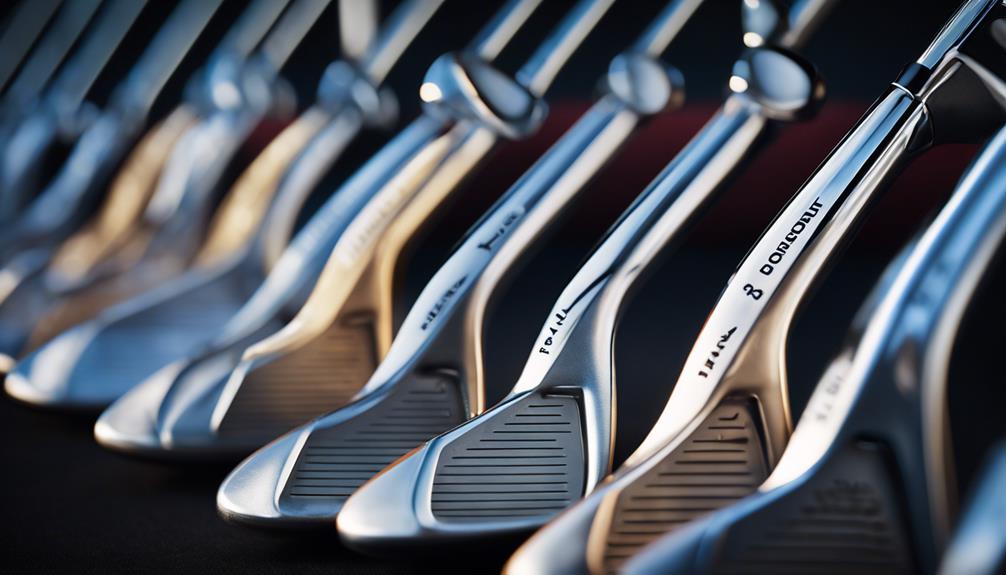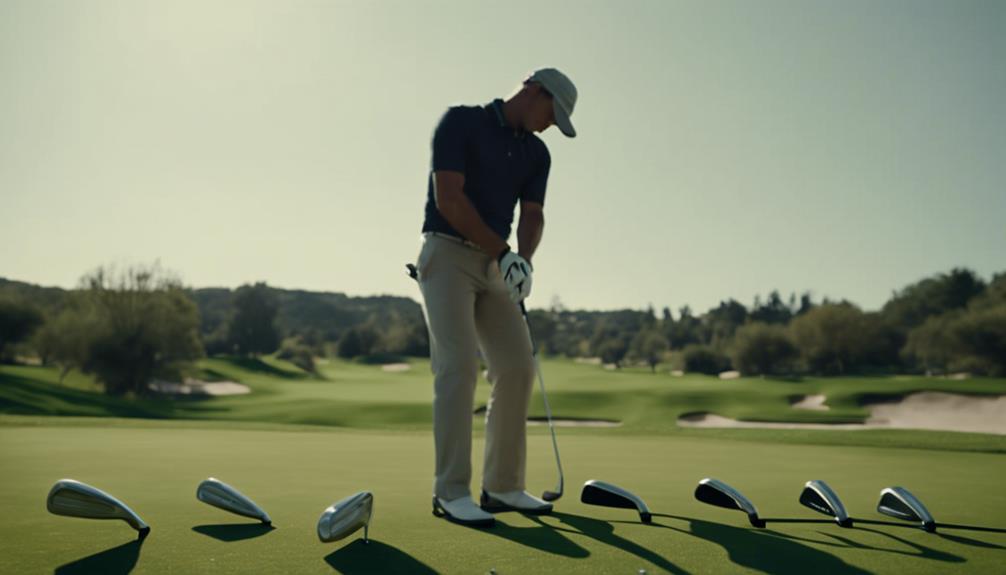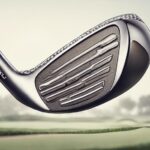- 7 Top Flite Golf Clubs XL for Improved Performance - September 28, 2024
- Top Flite Golf Clubs: Top 5 Reasons to Choose Them - September 28, 2024
- Top 3 Golf Club Fitters for a Perfect Swing - September 28, 2024
You'll use golf irons to hit shots from the fairway, rough, or sand, and to achieve a range of distances, trajectories, and spin rates. Irons are categorized into long, mid, and short types, each designed for specific purposes and distance gaps. With increasing loft angles and decreasing shaft lengths, irons help you precision-select shots. Understanding personal distances and choosing the right iron for your shot is key to effective gameplay. As you explore the world of golf irons, you'll discover more about their composition, characteristics, and maintenance – and how to access their full potential to elevate your game.
Key Takeaways
- Golf irons are used for shots requiring precision and control, typically from the fairway or rough, within 200 yards of the green.
- They help golfers achieve specific distances and trajectories, with lower-numbered irons for longer shots and higher-numbered irons for shorter shots.
- Irons are designed for approach shots, providing the necessary height and spin to land the ball on the green or close to the pin.
- Selection of the right iron depends on factors such as distance, trajectory, and spin, as well as the golfer's skill level and playing style.
Set Composition and Iron Types
When assembling a golf iron set, you typically start with a standard composition of eight clubs, ranging from 3-iron to pitching wedge (3-PW), which provides a solid foundation for tackling various shots on the course. This set makeup allows you to cover a range of distances and trajectories.
Irons are categorized into three types: long irons (2-4), mid-irons (5-7), and short irons (8-PW). Each type has its unique characteristics, with short irons being generally easier to hit due to their shorter shafts and higher lofts.
Within these categories, you'll find two primary iron types: cavity back and muscle back (blade). Cavity back irons, with their larger heads, offer forgiveness and are ideal for the average golfer. Muscle back irons, with their smaller heads, provide more control and appeal to skilled players.
When selecting irons, consider your skill level and playing style to determine the best fit for your game.
Loft, Length, and Distance Explained
As you assemble your iron set, understanding the nuances of loft, length, and distance becomes essential in optimizing your gameplay, particularly in selecting the right club for specific shots. Each iron, from 3-iron to pitching wedge, features increasing loft angles, which allows for precision in shot selection based on the desired height and distance. The shaft length decreases progressively from the 3-iron to the pitching wedge, with shorter clubs providing better control during swings.
Here's a breakdown of the typical iron set:
| Club | Average Distance |
|---|---|
| 3-iron | 180-200 yards |
| 7-iron | 140-160 yards |
| 9-iron | 120-140 yards |
| Pitching Wedge | 90-110 yards |
| Gap Wedge | 80-100 yards |
Understanding the relationship between club number and performance is vital. Loft increases as you move towards the pitching wedge, resulting in higher iron shots. Meanwhile, shaft length decreases, providing better control. With a typical yardage gap of 10-15 yards between clubs, consistency in distance gaps and understanding personal distances with each club are key to effective gameplay and club selection.
Iron Classification and Characteristics

As you explore the world of golf irons, you'll notice that they come in various types, each with its unique loft and characteristics.
You'll want to understand the differences between iron types, such as cavity back and muscle back (blade) configurations, as well as the materials used in their shafts.
Iron Types and Lofts
Golfers can categorize irons into three distinct groups – long, mid, and short irons – each designed to serve a specific purpose in their game.
Long irons (2-, 3-, and 4-irons) are for distance, mid-irons (5-, 6-, and 7-irons) are for medium range, and short irons (8-, 9-irons, and pitching wedge) are for precision shots near the green.
Each iron has a specific loft angle, with lower-numbered irons having less loft and producing lower ball flight and greater distance, while higher-numbered irons feature more loft for higher flight and shorter distance.
A typical distance gap between each iron ranges from 10 to 15 yards, allowing you to select the appropriate club based on required yardage to the target.
Muscle back (blade) irons are designed for skilled players seeking control and feedback.
Cavity back irons offer larger heads and more forgiveness, making them ideal for less experienced golfers.
The standard set of irons usually includes 3-iron to pitching wedge (3-PW), totaling eight clubs, with additional specialty wedges available separately for specific shot types.
Understanding these iron types and lofts will help you choose the right club for your shot, leading to improved accuracy and control in your game.
Iron Shaft Materials
You'll find that modern golf irons typically feature shafts made from two primary materials: steel and graphite, each with its unique characteristics and benefits.
Steel shafts offer greater feedback and durability, making them a popular choice among skilled golfers with faster swing speeds.
On the other hand, graphite shafts provide a lighter and more flexible alternative, enhancing swing speed and reducing overall club weight.
As you explore the world of golf clubs, you'll notice that graphite shafts have gained popularity among manufacturers for their ability to improve performance.
The choice of shaft material can considerably impact your game, influencing factors like control, distance, and feel during swings.
When selecting iron shafts, consider your swing speed and personal preferences.
Steel shafts are ideal for those seeking greater feedback, while graphite shafts are perfect for golfers looking to increase their swing speed.
Cavity Back Vs Blades
When it comes to iron classification, two primary categories emerge: cavity back irons and muscle back irons, each boasting distinct characteristics that cater to different skill levels and playing styles.
As a golfer, understanding the differences between these two categories is essential in selecting the right irons for your game.
Cavity back irons feature a larger clubhead with a hollowed-out back, providing forgiveness and a larger sweet spot. This design allows for more weight distribution around the perimeter, minimizing the effects of off-center hits. These irons are ideal for less experienced golfers who need a little more help with accuracy.
On the other hand, muscle back irons, or blades, have a smaller head size and are typically forged, offering better feedback and control. They promote a lower center of gravity, resulting in a more penetrating ball flight favored by advanced players. If you're looking for precision and feel, muscle back irons might be the way to go.
Your choice between cavity back and muscle back irons depends on your skill level and playing style.
- Cavity back irons provide forgiveness and a larger sweet spot.
Understanding Iron Distances and Gaps
To effectively navigate the course, it is essential to understand the distance gaps between your irons, which typically range from 10 to 15 yards between each club. This knowledge allows you to hit each club with confidence, knowing exactly how far the ball will travel.
| Iron | Average Distance |
|---|---|
| 3-iron | 200 yards |
| 5-iron | 180 yards |
| 7-iron | 160 yards |
| 9-iron | 140 yards |
When selecting an iron from your set, consider the distance you need to cover. Lower-numbered irons, such as the 3-iron and 4-iron, have less loft and produce longer shots. In contrast, higher-numbered irons, like the 8-iron and pitching wedge, have more loft for shorter, higher shots. Understanding your individual averages for each club is essential, as distances may vary greatly depending on your skill level and swing technique. By mastering the distance gaps between your irons, you'll be able to choose the right club for the shot, resulting in more accurate and controlled play.
Choosing the Right Iron for Shots

Selecting the right iron for your shot requires careful contemplation of the distance, trajectory, and spin you need to achieve, as each iron is designed to produce a specific outcome. When choosing an iron, you'll want to reflect on the numbered designation, as lower-numbered irons are designed for longer distances with less loft, while higher-numbered irons provide more loft for shorter, more precise shots.
Here are some key factors to keep in mind:
- Long irons (2-, 3-, and 4-irons) are ideal for penetrating ball flight and distance, making them perfect for long approach shots.
- Mid-irons (5-, 6-, and 7-irons) and short irons (8-, 9-irons, and pitching wedge) are better suited for approach shots and precision around the green.
Iron Maintenance and Wear Over Time
As you use your golf irons, you'll notice wear patterns emerging, and it's crucial to understand these patterns to maintain peak performance.
You'll want to pay close attention to groove deterioration rates, as worn-down grooves can lead to decreased spin and control.
Iron Wear Patterns
Your golf irons are constantly undergoing wear and tear, with the grooves gradually deteriorating over time and impacting your overall performance on the course. This wear pattern affects not only the irons used to produce shots but also your ability to maintain better control over the golf ball.
As you play, the grooves on your irons experience wear, leading to reduced spin and control on shots.
Here are some key things to keep in mind:
- The rate of wear varies between forged and cast irons, with forged irons deteriorating faster.
- Regular inspection of iron faces and grooves is essential to identify wear early on.
Groove Deterioration Rate
You can expect your golf irons' grooves to deteriorate at a rate that's influenced by factors like material properties and usage frequency. For instance, softer forged irons tend to wear down faster than cast clubs, which means you might need to replace them more often. As you hit the ball with your long irons or gap wedge, the grooves will gradually deteriorate, affecting the club's performance and your shot accuracy.
Here's a rough estimate of the groove deterioration rate based on the number of shots:
| Number of Shots | Expected Groove Deterioration |
|---|---|
| 10,000 – 20,000 | Slight wear, minimal impact on performance |
| 20,000 – 40,000 | Noticeable wear, slight decrease in spin and control |
| 40,000 – 60,000 | Significant wear, decreased ball control and distance consistency |
| 60,000 – 80,000 | Substantial wear, major impact on performance and shot accuracy |
| 80,000+ | Extreme wear, club potentially unusable |
Regularly inspecting and maintaining your irons can help prolong their lifespan and preserve peak performance. By understanding the groove deterioration rate, you can make informed decisions about when to replace your club to use and enhance your game.
Frequently Asked Questions
What Do You Use an Iron for Golf?
You use an iron for golf to execute precise approach shots, leveraging iron types like long, mid, and short irons, considering iron distance ranges, iron materials' forgiveness, and mastering iron techniques like ball position and swing tempo.
When Should I Use My Irons?
When deciding when to use your irons, consider iron selection tips: assess distance needs, choose the right club for iron distance control, and focus on improving iron accuracy by selecting the best iron type for your shot.
What Are Irons Used For?
You master iron play by understanding iron types, leveraging iron advantages like precision and control, practicing iron techniques like ball positioning, and prioritizing iron maintenance to optimize performance and take your game to the next level.
What Do the Different Irons Mean in Golf?
When selecting an iron, you choose from various types, each designed for specific distances and ball flights, requiring you to contemplate club selection, distance control, and swing mechanics to master the perfect shot.
Conclusion
As you walk off the 18th hole, victorious, you realize your trusty irons have been your loyal companions throughout the game.
Like a skilled blacksmith shaping medieval swords, you've wielded these clubs to precision, harnessing their unique characteristics to conquer the course.
Now, as you slip them back into your bag, you appreciate the harmony between your swing and the irons' design.
Knowing that with practice and patience, you'll continue to forge unforgettable rounds.




